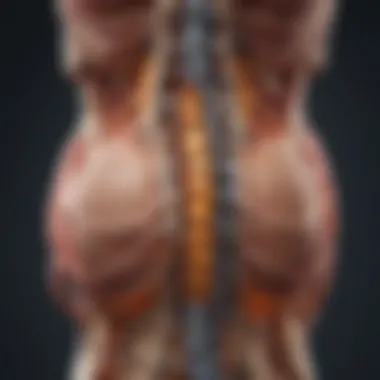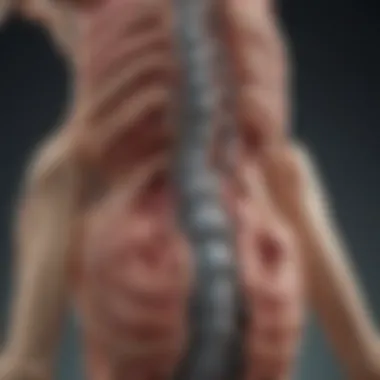Exploring Complications of Spinal Fusion Surgery


Intro
Spinal fusion surgery is often considered a necessary intervention for stabilizing various spinal conditions. Nevertheless, it comes with an array of potential complications that can significantly affect patient outcomes. Understanding these complications provides crucial insight for students, researchers, educators, and healthcare professionals alike. This article aims to unravel the complexities of spinal fusion complications, focusing on their types, associated risk factors, and strategies for prevention and management.
The objective is to achieve a thorough comprehension of the pre-operative and post-operative challenges that these patients may face. As the significance of careful patient selection and extensive planning becomes apparent, this discussion will enhance the knowledge base surrounding spinal fusion procedures.
Understanding Spinal Fusion
Spinal fusion is a surgical procedure designed to stabilize specific segments of the spine. In this section, the focus is on understanding what spinal fusion entails and why it is crucial to appreciate both the benefits and risks associated with it. The ongoing debate surrounding the effectiveness and safety of spinal fusion procedures requires a thorough analysis of the underlying principles and practices.
Definition and Purpose
Spinal fusion is defined as a surgical intervention in which two or more vertebrae are permanently joined together. The procedure involves the placement of bone grafts or synthetic materials between the vertebrae, with the goal of promoting bone healing and achieving a solid union. This process blocks motion at the affected site, aiming to relieve pain or instability often caused by degeneration or injury. The primary purpose is to enhance spinal stability, which in turn can improve overall function for patients suffering from various spinal disorders.
Surgical Techniques Employed
Various surgical techniques are adopted in spinal fusion, depending on the specific condition being addressed. Common methods include:
- Anterior approach: This involves accessing the spine from the front of the body, often through a small incision in the abdomen. It can be effective for conditions such as herniated discs or spinal stenosis.
- Posterior approach: Here, the incision is made on the back, allowing direct access to the vertebrae. This is suitable for fusion at certain spine levels.
- Transforaminal approach: A less invasive option where the surgeon approaches the fusion site through the existing bony openings (foramina) in the spine.
Each technique is selected based on factors such as the exact location of the problem, the patient's anatomy, and the surgeon's expertise.
Indications for Surgery
Indications for spinal fusion vary but include:
- Degenerative disc disease: When the discs between vertebrae deteriorate, causing pain and instability.
- Spinal stenosis: A narrowing of the spinal canal, which can compress the nerves and cause discomfort.
- Spondylolisthesis: A condition where one vertebra slips over another, leading to instability and pain.
- Severe spinal deformities: Such as scoliosis, which can adversely affect function and quality of life.
- Post-traumatic instability: Resulting from fractures or significant injuries.
In essence, spinal fusion serves to manage chronic back pain, restore alignment, and improve mobility. Understanding the surgical context is vital as it lays the groundwork for appreciating the potential complications that may arise.
Types of Complications
Understanding the types of complications arising from spinal fusion is vital for anyone involved in patient care. This section provides a structured overview of potential complications that may occur. These complications can significantly impact recovery and quality of life. By identifying these risk factors, healthcare professionals can tailor their approaches to prevent and manage possible adverse outcomes.
Acute Surgical Complications
Acute surgical complications refer to issues that arise during or shortly after the surgical procedure. These can include excessive bleeding, thrombosis, or an adverse reaction to anesthesia. Anesthesia complications can jeopardize patient safety. Thrombosis, or blood clots, presents a significant risk and requires proactive measures to mitigate. Patients may also experience nerve damage during the surgical procedure, which can lead to pain or loss of function.
It’s essential for surgical teams to monitor patients closely during and post-surgery. Establishing protocols for rapid intervention can improve outcomes. Complications like these underscore the importance of surgical expertise and preparedness in managing complex cases.
Chronic Post-Operative Complications
Chronic post-operative complications manifest after discharge. These complications may not appear until weeks or months later. They often include ongoing pain, reduction in mobility, or psychological issues, such as depression related to chronic pain. The psychological effects can be profound. Patients may experience feelings of disappointment, anxiety, or helplessness regarding their recovery.
Long-term follow-ups can be invaluable in identifying these issues early. By understanding these complications, healthcare providers can implement supportive interventions to assist healing and rehabilitation. It is essential to differentiate between expected post-operative pain and complications that warrant further investigation.
Infection Risks
Infection risks are always a factor in surgical procedures, and spinal fusion is no exception. Surgical site infections can significantly impact recovery. Signs of infection include redness, swelling, and increased pain at the site of surgery. Severe infections can lead to systemic problems, including sepsis, which is life-threatening if not managed promptly.


Preventive measures include meticulous surgical technique, appropriate antibiotic use, and sterile environments. Post-operative education on care at home is also crucial for patients.
Non-Union or Pseudarthrosis
Non-union, or pseudarthrosis, is a problematic complication where bones do not heal properly after fusion. This condition can lead to continued instability and chronic pain. Factors causing non-union include inadequate immobilization, infection, and poor bone quality. The diagnosis may require imaging to observe the fusion site.
Management of pseudarthrosis usually involves additional surgical interventions. This emphasizes the importance of patient assessment during pre-operative planning to identify potential risks, ensuring a strategy that focuses on achieving solid fusion.
Nerve Injury
Nerve injury is another potential complication affecting spinal fusion patients. It can occur during surgery, resulting in weakness, numbness, or motor deficits. Prevention requires a thorough understanding of spinal anatomy, vigilance during the procedure, and proper patient positioning.
Early recognition of nerve injuries can aid in better recovery outcomes. Rehabilitation strategies play a critical role in addressing any resulting deficits.
Adjacent Segment Disease
Adjacent segment disease (ASD) refers to the degeneration of spinal segments adjacent to the site of fusion. As one area of the spine is stabilized, neighboring segments may experience increased stress. This can lead to pain and require further intervention. Evaluating a patient’s spinal health pre-operatively is vital to predicting the risk of ASD.
Monitoring and addressing the overall health of the spine post-fusion can help manage this condition effectively. Educating patients about spinal health and lifestyle modifications can play a role in reducing the incidence of ASD, thus improving long-term outcomes.
Managing complications in spinal fusion surgery is essential for optimal patient outcomes. With careful consideration, complications can be minimized, enhancing recovery and function.
Risk Factors for Complications
Understanding the risk factors for complications in spinal fusion is critical for enhancing patient safety and surgical outcomes. These elements play a significant role in pre-operative assessments and help inform both patients and healthcare providers about potential challenges. Identifying these factors allows clinicians to tailor their strategies for each individual, thereby minimizing risks associated with the procedure. This section will explore three primary categories of risk factors: patient-related, surgery-related, and post-operative care considerations.
Patient-Related Factors
Patient-related factors encompass a range of elements that can influence the likelihood of complications post-surgery. Age, overall health, and lifestyle choices significantly affect surgical outcomes. Older patients may experience longer recovery times and increased risks due to pre-existing health conditions such as diabetes or osteoporosis.
Obesity is another critical factor. Higher body mass index (BMI) is linked to complications like wound healing issues, higher infection rates, and congenital conditions that can lead to instability in the spine. Additionally, patients who smoke may face a higher risk of complications. Smoking impairs blood flow and delays healing, thus increasing the chance of non-union or pseudarthrosis after the procedure.
It is essential for surgeons to conduct thorough evaluations of these factors prior to surgery. Engaging patients in discussions about their health is key to achieving better outcomes.
Surgery-Related Factors
Surgery-related factors are pivotal in determining the success of spinal fusion. These factors can include the complexity of the procedure, choice of anesthesia, and the surgeon's experience. Complex procedures that involve multiple vertebral segments tend to have higher complication rates owing to longer operation times and increased tissue manipulation.
The choice of surgical technique, whether it involves traditional open surgery or minimally invasive methods, can also impact outcomes. Minimally invasive techniques are often associated with less soft tissue damage, reduced postoperative pain, and quicker recovery times, although they may not be suitable for all patients.
In addition, the skill and experience level of the surgical team play a significant role in minimizing risks. Surgeons well-versed in spinal procedures can anticipate and manage potential complications more effectively.
Post-Operative Care Considerations
Post-operative care is crucial for minimizing complications after spinal fusion. The initial recovery period after surgery requires close monitoring, particularly for signs of infection or neurological deficits. Healthcare providers must ensure proper pain management strategies are in place.
Physical therapy should be integrated into the recovery plan as soon as possible. Ambulation and gentle exercises can aid in healing and help prevent complications like deep vein thrombosis.
Lastly, patient education is important. Providing clear instructions for care at home, including activity limitations and signs to watch for, fosters a proactive approach to recovery. Regular follow-ups are necessary, to address any emerging issues and ensure the patient is healing properly.


"A proactive approach to post-operative care is essential for reducing complications and enhancing recovery outcomes."
Prevention Strategies
The significance of prevention strategies in spinal fusion cannot be overstated. Understanding how to mitigate potential complications is vital for improving surgical outcomes. Proper planning and execution can significantly reduce the risk factors associated with post-operative complications. Implementing preventive measures is necessary not only for the success of the surgery but also for the overall health and well-being of the patient.
Comprehensive Pre-Operative Assessment
A thorough pre-operative assessment is essential to identify any patient-specific factors that could lead to complications. This assessment typically involves a detailed medical history, physical examination, and possibly imaging studies. During this process, physicians evaluate various elements such as the patient's age, medical conditions, and current medications. Additionally, it is crucial to consider psychosocial factors that may influence patient compliance and overall outcomes.
"Assessment serves as the foundation for effective prevention strategies, ensuring that all potential risk factors are addressed prior to surgery."
The goal of this phase is to comprehensively understand the patient's health status. This enables the surgical team to tailor the surgical plan accordingly. It may include optimization of any underlying conditions, such as diabetes or obesity, to enhance surgical safety.
Optimizing Patient Health
Optimizing patient health before spinal fusion surgery can vastly improve healing and reduce complications. This includes controlling pre-existing health issues and encouraging lifestyle changes. For instance, managing blood sugar levels in diabetic patients or promoting weight loss in those who are overweight can help lessen surgical risks. Engaging patients in prehabilitation programs can also strengthen muscles and improve cardiovascular fitness. This proactive approach is essential for creating a resilient patient ready for surgery and recovery.
Furthermore, education plays a critical role. Informing patients about what to expect before and after surgery fosters a partnership in care. Patients who are better informed are more likely to adhere to post-operative protocols, leading to improved outcomes.
Surgical Technique Modifications
The landscape of spinal fusion techniques continues to evolve, with advancements aiming to reduce complications significantly. Surgeons may employ less invasive techniques, leading to shorter recovery times and reduced tissue trauma. Modifications such as the use of navigation systems can increase precision during the procedure. This not only minimizes the likelihood of nerve damage but also helps in achieving proper alignment of spinal segments.
Surgeons increasingly explore the use of bone graft alternatives and synthetic materials, which may improve fusion rates and diminish the risk of complications. Each of these innovations represents a step towards enhancing both the effectiveness and safety of spinal fusion procedures.
In summary, implementing rigorous prevention strategies is essential for optimizing outcomes in spinal fusion cases. A combination of meticulous pre-operative assessment, health optimization, and advanced surgical techniques can lead to more favorable results for patients.
Management of Complications
Understanding how to manage complications following spinal fusion is essential for ensuring optimal patient outcomes. While the prospect of surgery brings hope for relief from pain and improved function, complications can arise that hinder recovery. Effective management tactics significantly enhance recovery and can reduce the severity and frequency of adverse outcomes. The considerations in this section focus on immediate interventions, long-term follow-up, and rehabilitation strategies—each playing a critical role in the patient's journey post-surgery.
Immediate Post-Operative Interventions
The phase immediately following surgery is crucial. Close monitoring of patients is vital to identify any complications early. Common immediate complications may include blood loss, infections, or issues with anesthesia. Prompt diagnosis and treatment can prevent minor issues from evolving into major concerns.
Some of the key interventions in this phase include:
- Monitoring Vital Signs: Regular checking of pulse, blood pressure, and respiratory rate helps detect any giving signs of complications.
- Pain Management: Adequate pain control can improve patient comfort and promote mobility, which is essential in preventing complications like blood clots.
- Wound Care: Proper management of the surgical site reduces the risk of infection. Keeping the area clean and observing for any abnormal signs is critical.
Early intervention not only addresses possible complications but also builds patient trust in their care team. Ensuring clear communication about the patient's progress aids in understanding and addressing concerns.
Long-Term Follow-Up Strategies
Long-term follow-up care is an essential component in managing complications of spinal fusion. This ongoing interaction serves multiple purposes, including assessing the fusion's success and evaluating for potential complications such as adjacent segment disease or non-union.
Follow-up strategies should involve:
- Regular Check-Ups: Scheduled appointments facilitate assessments of recovery, identify complications, and guide future management.
- Imaging Studies: Radiographic evaluations, such as X-rays or MRI, may be necessary to visualize the spinal segments and evaluate fusion integrity over time.
- Patient Education: Informing patients about warning signs to look out for postoperatively can lead to quicker responses if complications arise.


Additionally, maintaining communication with healthcare professionals about any new symptoms ensures a proactive approach to long-term success.
Rehabilitation Approaches
Rehabilitation is vital in helping patients return to their normal activities after spinal fusion. A tailored rehabilitation program not only enhances recovery but also reduces the likelihood of long-term complications.
Key elements for effective rehabilitation include:
- Physical Therapy: Engaging in targeted exercises helps restore strength and flexibility. A physical therapist can design a specific program to address individual needs.
- Pain Management Techniques: Methods such as modalities may be used alongside physical therapy to manage pain and improve function without heavily relying on medications.
- Gradual Return to Activities: Patients should be guided on how to ease back into regular activities safely and sensibly to avoid straining the surgical site.
Current Research and Future Directions
Advancements in spine surgery have become an area of intense focus, particularly regarding spinal fusion procedures. Understanding current research and future directions is crucial for improving patient outcomes. The overarching goal is to identify innovative solutions that can mitigate complications commonly associated with spinal fusion. This not only allows for safer surgical procedures but also enhances the quality of life for patients recovering from spine surgery.
Innovations in Surgical Techniques
Innovations in surgical techniques have significantly altered the landscape of spinal fusion. These advancements include minimally invasive surgery, robotic-assisted systems, and refined methods of bone grafting. Minimally invasive techniques, in particular, aim to reduce tissue damage and promote faster recovery.
Robotic-assisted surgery offers enhanced precision and consistency in surgical procedures. It decreases the likelihood of human error, resulting in improved outcomes. Techniques such as endoscopic fusion have also gained traction, allowing for better visualization of the surgical field while minimizing trauma to surrounding tissues.
Such innovations are essential in addressing complications by enabling surgeons to execute procedures with greater accuracy. The integration of these advanced surgical technologies also facilitates better patient education and understanding of their treatment options.
Advancements in Imaging Technologies
Imaging technologies play a vital role in diagnosing and monitoring complications following spinal fusion. Advances such as high-definition MRI and 3D imaging improve the assessment of spinal alignment and fusion status post-surgery. These technologies provide surgeons with critical information during and after the operation, making it easier to track healing and detect complications early.
Moreover, intraoperative imaging, like fluoroscopy, allows for real-time feedback during surgery. This capability ensures that the fusion is performed correctly and decreases the chances of adjacent segment disease. Enhanced imaging techniques not only improve surgical precision but also contribute to tailored postoperative care.
Emerging Treatment Modalities
Emerging treatment modalities are paving the way for better management of complications related to spinal fusion. Stem cell therapy and biologics represent two of the most promising areas of research. Stem cell therapy focuses on utilizing the body’s regenerative capabilities to promote healing and bone union. On the other hand, biologics like bone morphogenetic proteins are designed to stimulate bone growth and aid in the fusion process.
Additionally, ongoing research into patient-specific implants and customized surgical plans offers potential for greater individualization in treatment approaches. Individualizing care based on a patient's unique anatomy and condition can lead to significantly improved outcomes and reduce the risk of complications.
Innovations in surgery and treatments focus on safety and recovery. Better tools and methods mean fewer complications and improved satisfaction.
Overall, the present focus on research and advancements is pivotal for establishing effective protocols. As awareness and understanding of spinal fusion complications grow, it is essential to continue exploring innovative surgical techniques, imaging advancements, and emerging treatment modalities.
Culmination
In the context of spinal fusion, understanding the implications of this procedure is essential. The complexities associated with the surgery present significant challenges, which can severely affect a patient’s quality of life post-operation. As we have explored, complications can arise at various stages, making it crucial for both patients and healthcare providers to be informed.
Summary of Key Points
The primary complications discussed include:
- Acute surgical complications, such as excessive bleeding or organ injury.
- Chronic post-operative complications, including ongoing pain and reduced mobility.
- Infection risks that can lead to severe health issues.
- Non-union or pseudarthrosis, where proper healing does not occur.
- Nerve injury, which can result in nerve damage and loss of function.
- Adjacent segment disease, where nearby spinal segments suffer due to altered mechanics.
Understanding these complications underscores the importance of identifying risk factors like patient health and surgical methods, enhancing pre-operative assessments and optimizing post-operative care.
The Importance of Comprehensive Care
Implementing a comprehensive care approach when managing spinal fusion is paramount. This care should encompass both pre-operative preparations and post-operative support. By focusing on patient-specific considerations, such as underlying health conditions and lifestyle habits, surgeons can tailor their methods to improve surgical outcomes. Moreover, ongoing support through rehabilitation is critical, as it aids recovery and reduces the risk of complications.
Through thorough patient education and postoperative monitoring, healthcare providers can assist patients in navigating the complexities of spinal fusion and its associated risks. Ultimately, a well-rounded care strategy not only minimizes complications but also enhances overall patient satisfaction.





